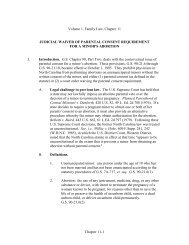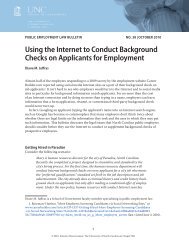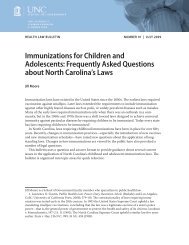Responding to Subpoenas for Health Department Records
Responding to Subpoenas for Health Department Records
Responding to Subpoenas for Health Department Records
- No tags were found...
You also want an ePaper? Increase the reach of your titles
YUMPU automatically turns print PDFs into web optimized ePapers that Google loves.
September 2005 <strong>Health</strong> Law Bulletin No. 82most cases, the health department will not beresponsible <strong>for</strong> notifying the patient or moving <strong>for</strong>the protective order. 58 Rather, the department will berelying on written documentation from thesubpoenaing party demonstrating that he or she hascomplied with the HIPAA procedures.The types of documentation the healthdepartment should look <strong>for</strong> will vary depending onwhether the subpoenaing party complied with thenotice provisions or the qualified protective orderprovisions. If the subpoenaing party complied withthe notice requirements, the health department shouldexpect a written statement explaining that thesubpoenaing party has made an attempt <strong>to</strong> providewritten notice <strong>to</strong> the patient (which may be bymailing the notice <strong>to</strong> the patient’s last knownaddress) and “accompanying documentation”demonstrating that fact. While the Privacy Rule doesnot define the term “accompanying documentation,”in this context it could mean (a) a copy of the noticeand (b) a copy of any official court record indicatinghow objections <strong>to</strong> the subpoena (if any) wereresolved by the court or the parties. It must be clearfrom the statement and/or the accompanyingdocumentation that the patient had an opportunity <strong>to</strong>object <strong>to</strong> the disclosure and the patient either did no<strong>to</strong>bject or objected and the objection was resolved.If the subpoenaing party complied with thequalified protective order requirements, the healthdepartment should expect a written statementexplaining that the subpoenaing party has eitherrequested a qualified protective order from the cour<strong>to</strong>r the parties <strong>to</strong> the dispute have agreed in advance <strong>to</strong>58. The Privacy Rule does allow the health department<strong>to</strong> take the initiative <strong>to</strong> provide notice <strong>to</strong> the patient or seeka qualified protective order. 45 C.F.R. 164.512(e)(vi).While a department may wish <strong>to</strong> pursue one of theseoptions, it must balance the administrative burdens of theseef<strong>for</strong>ts against the burdens associated with complying withthe subpoena without using the mail-in procedure. It maybe that written notice <strong>to</strong> the patient would be relativelysimple, but the notice must meet all of the criteria inHIPAA. Specifically, the notice must identify the litigationand offer the individual an opportunity <strong>to</strong> raise an objection<strong>to</strong> the court. After giving notice, the health departmentmust refrain from disclosing any in<strong>for</strong>mation until the timeperiod in which the individual may object has elapsed andeither no objections were filed or all the individual’sobjections were resolved in a manner that permits thedisclosure. If the department elects <strong>to</strong> follow theseprocedures, it should have clear, written policies andprocedures <strong>for</strong> staff members <strong>to</strong> follow and require staffmembers <strong>to</strong> carefully document their ef<strong>for</strong>ts.a qualified protective order and have presented theorder <strong>to</strong> the court. The term “qualified protectiveorder” has a particular meaning in this context. 59 Inshort, it is an order that limits the use and disclosureof the in<strong>for</strong>mation and requires that the in<strong>for</strong>mation(including any copies made) be returned ordestroyed. The “accompanying documentation” inthis context would likely be a copy of the motion <strong>for</strong>a protective order and possibly any court recordsdemonstrating that the motion has been submitted(which may simply be a stamp on the face of theorder itself).In the absence of documentation related <strong>to</strong> eitherpatient notice or a qualified protective order, thehealth department should not follow the mail-inprocedure. Rather, it should appear in court at thedesignated time. Remember that the mail-inprocedure is optional; a health department could elect<strong>to</strong> establish a policy of always appearing in person <strong>to</strong>obtain a court order. While such a policy could meanmore administrative burdens <strong>for</strong> the department, itwould ensure that confidential records are protecteduntil the court issues its order. When records aremailed in, the health department has no way ofknowing whether they remained under seal until thecourt ordered disclosure.Question 31. How should I respond if thesubpoena directs me <strong>to</strong> testify in court orat a deposition and I anticipate that thequestions will solicit confidentialin<strong>for</strong>mation?A subpoena directing you <strong>to</strong> testify will specify atime and place <strong>for</strong> you <strong>to</strong> appear. If the subpoenarequires you <strong>to</strong> come <strong>to</strong> court <strong>to</strong> testify, you shouldmake every ef<strong>for</strong>t <strong>to</strong> appear at the designated timeand place. When asked <strong>to</strong> disclose in<strong>for</strong>mation that isconfidential under state or federal law, you shouldbriefly explain the legal restrictions <strong>to</strong> the presidingjudge. If the judge orders you <strong>to</strong> disclose thein<strong>for</strong>mation, then you may do so. Disclosingconfidential in<strong>for</strong>mation when ordered <strong>to</strong> do so by ajudge is allowed under state and federal law. 60 Thecourt’s order is not required <strong>to</strong> be in writing.59. 45 C.F.R. 164.512(e)(1)(v) (outlining therequirements of a qualified protective order).60. See 45 C.F.R. 154.512(a) (HIPAA Privacy Ruleprovision authorizing disclosures required by law,including court ordered disclosures); G.S. 8-53 (statephysician-patient privilege law authorizing disclosure whenordered <strong>to</strong> do so by a district or superior court judge upon a17













